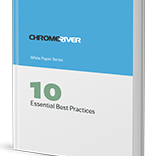In this third and final part of our three-part series, we will conclude our discussion on accounts payable best practices fueled by the excellent article "9 Best Practices for Automating Your AP Department" written by David Schmidt and Katie McMurry for the third-quarter printing of Financial Operations Matters. It provides an excellent roadmap for automation that is both commonsensical and actionable.
Step 7: Take Control of Your Discount Opportunities
One of the primary benefits of automating your Accounts Payable process is the improved visibility into payment liabilities. While this is a significant financial-planning benefit, there is also an incredible opportunity to create a return on capital through early-payment discounts. By employing a more efficient invoice-coding and approval process, invoices can be paid early instead of on time (or late). Just by taking advantage of a 2% Net 10 Days discount, organizations are able to achieve an annualized 36% rate of return! Given that the average invoice receipt-to-pay cycle time is 23 days with a manual process, vs. an automated AP process of just a few days, the return on investment quickly becomes a "no brainer" case for automation.
Step 8: Define Your Payment Processing Procedures
Without the proper procedures around invoice receipt and approval, there is some degree of risk related to duplicate and erroneous payments. This leads to profit leakage and is the reason that invoice audit and recovery services have grown into a billion-dollar industry. The problem is, trying to get money back once the check has been deposited, especially from one-off or occasional suppliers, can be a challenge in itself. In a manual environment, looking for duplicate invoices or trying to identify erroneous invoices can be a daunting, resource-intensive task. Additional benefits of Accounts Payable Automation Software are the powerful algorithms for automated duplicate checking and random sampling spot-checking. Potential duplicate invoices can be flagged and pulled out of the process so they can be reviewed and resolved prior to payment.
Step 9: Measure Your Progress
Whether you implement some or all of the previously recommended best practices, it's important that you benchmark your current state prior to automation and then measure your post-implementation progress. Through the use of Key Performance Indicators and ANALYTICS Reporting, the effectiveness of your process-improvement changes can be measured and shared with management. Don't forget to include operational, financial and user-satisfaction measurements for a true look at the big picture. Classic examples include cycle-time reduction, cost-per-invoice calculations, and tracking the increase of on-time and early-pay payments to suppliers.
it's important that you benchmark your current state prior to automation and then measure your post-implementation progress. Through the use of Key Performance Indicators and ANALYTICS Reporting, the effectiveness of your process-improvement changes can be measured and shared with management. Don't forget to include operational, financial and user-satisfaction measurements for a true look at the big picture. Classic examples include cycle-time reduction, cost-per-invoice calculations, and tracking the increase of on-time and early-pay payments to suppliers.
Now that you are armed with nine best practices for accounts payable automation, it's time to take action! Remember, like Ben Franklin said, "You may delay, but time will not."
Good luck, and let us know if these best practices have helped you get your invoice groove on.
Subscribe
Latest Posts
Posts by Category
I just love the Chrome River application. I could probably sell it! Finance Administrative Coordinator Law Firm, 800 Employees
Can’t we just move year-end, so that we can roll out Chrome River sooner!? Financial Systems Director Law Firm, 300 Employees

Comments